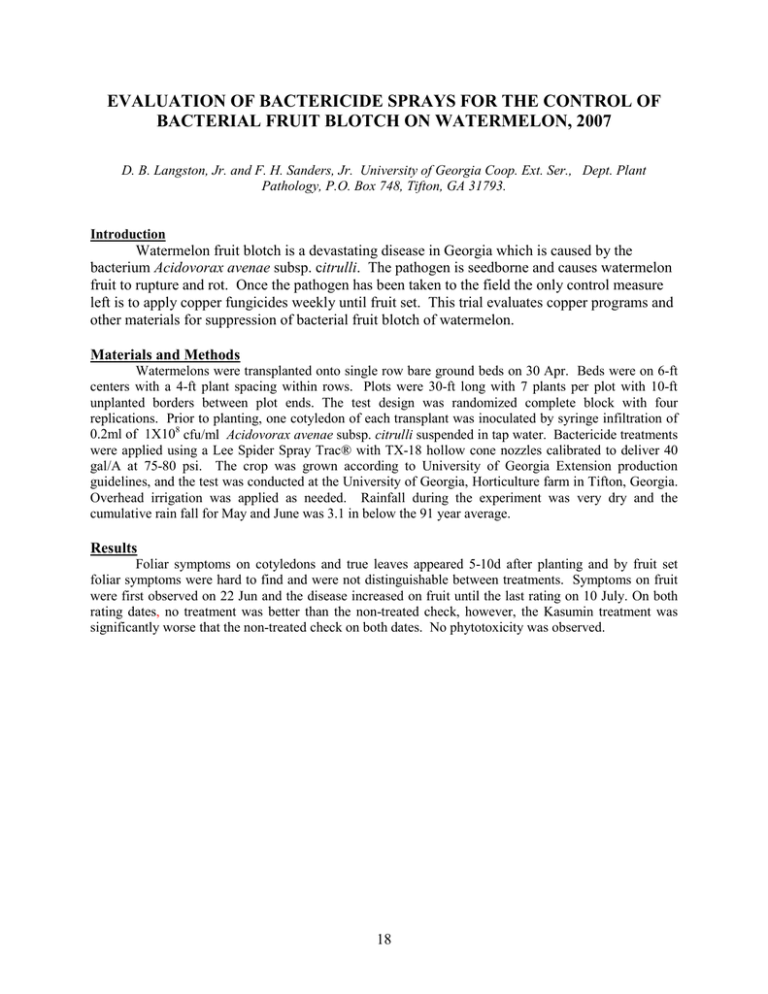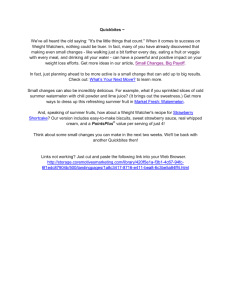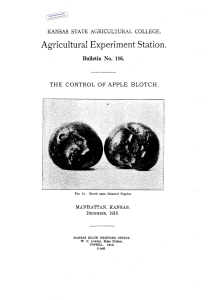EVALUATION OF BACTERICIDE SPRAYS FOR THE CONTROL OF
advertisement

EVALUATION OF BACTERICIDE SPRAYS FOR THE CONTROL OF BACTERIAL FRUIT BLOTCH ON WATERMELON, 2007 D. B. Langston, Jr. and F. H. Sanders, Jr. University of Georgia Coop. Ext. Ser., Dept. Plant Pathology, P.O. Box 748, Tifton, GA 31793. Introduction Watermelon fruit blotch is a devastating disease in Georgia which is caused by the bacterium Acidovorax avenae subsp. citrulli. The pathogen is seedborne and causes watermelon fruit to rupture and rot. Once the pathogen has been taken to the field the only control measure left is to apply copper fungicides weekly until fruit set. This trial evaluates copper programs and other materials for suppression of bacterial fruit blotch of watermelon. Materials and Methods Watermelons were transplanted onto single row bare ground beds on 30 Apr. Beds were on 6-ft centers with a 4-ft plant spacing within rows. Plots were 30-ft long with 7 plants per plot with 10-ft unplanted borders between plot ends. The test design was randomized complete block with four replications. Prior to planting, one cotyledon of each transplant was inoculated by syringe infiltration of 0.2ml of 1X108 cfu/ml Acidovorax avenae subsp. citrulli suspended in tap water. Bactericide treatments were applied using a Lee Spider Spray Trac® with TX-18 hollow cone nozzles calibrated to deliver 40 gal/A at 75-80 psi. The crop was grown according to University of Georgia Extension production guidelines, and the test was conducted at the University of Georgia, Horticulture farm in Tifton, Georgia. Overhead irrigation was applied as needed. Rainfall during the experiment was very dry and the cumulative rain fall for May and June was 3.1 in below the 91 year average. Results Foliar symptoms on cotyledons and true leaves appeared 5-10d after planting and by fruit set foliar symptoms were hard to find and were not distinguishable between treatments. Symptoms on fruit were first observed on 22 Jun and the disease increased on fruit until the last rating on 10 July. On both rating dates, no treatment was better than the non-treated check, however, the Kasumin treatment was significantly worse that the non-treated check on both dates. No phytotoxicity was observed. 18 Evaluation of products for suppression of bacterial fruit blotch of watermelon. Fruit Blotchy Treatments, rates, and (spray times)z 2 July 10 July Non-treated check…………………………………………………................. Serenade max 14.6% WP, 1.5 lb/A, (1,2,3,4,5) Kocide 3000 30% WP, 1.25 lb/A, (1,2,3,4,5)………………………………... Serenade max 14.6% WP, 1.5 lb/A, (1,2,3,4,5) Kocide 3000 30% WP, 0.5 lb/A, (1,2,3,4,5)…………………………….…… 1.3 bx 1.8 b 1.3 b 0.8 b 1.3b 2.3 ab Kocide 3000 30% WP, 0.5 lb/A, (1,2,3,4,5)…………………………….…… 0.5 b 1.0 b Kocide 3000 30% WP, 1.25 lb/A, (1,3,5)………………………………..…... 1.3 b 1.8 b Kocide 3000 30% WP, 1.25 lb/A, (1,2,3,4,5)………………………..………. Kocide 3000 30% WP, kocide rate? (1,3,5) Kasumin 2% L, 100ppm/A, (2,4)…………………………….……….……... 0.3 b 0.8 b 0.5 b 1.3 b Kasumin 2% L, 100ppm/A, (1,2,3,4,5)……………………………..……….. 3.3 a 4.0 a z Spray dates were: 1=24 May; 2=30 May; 3=6 Jun; 4=14 Jun; 5=13 Jun; 6=20 Jun yFruit blotch incidence was rated by counting the number fruit with symptoms in each plot. xMeans followed by the same letter(s) are not significantly different according to Fisher’s protected LSD test at P≤ 0.05. 19






